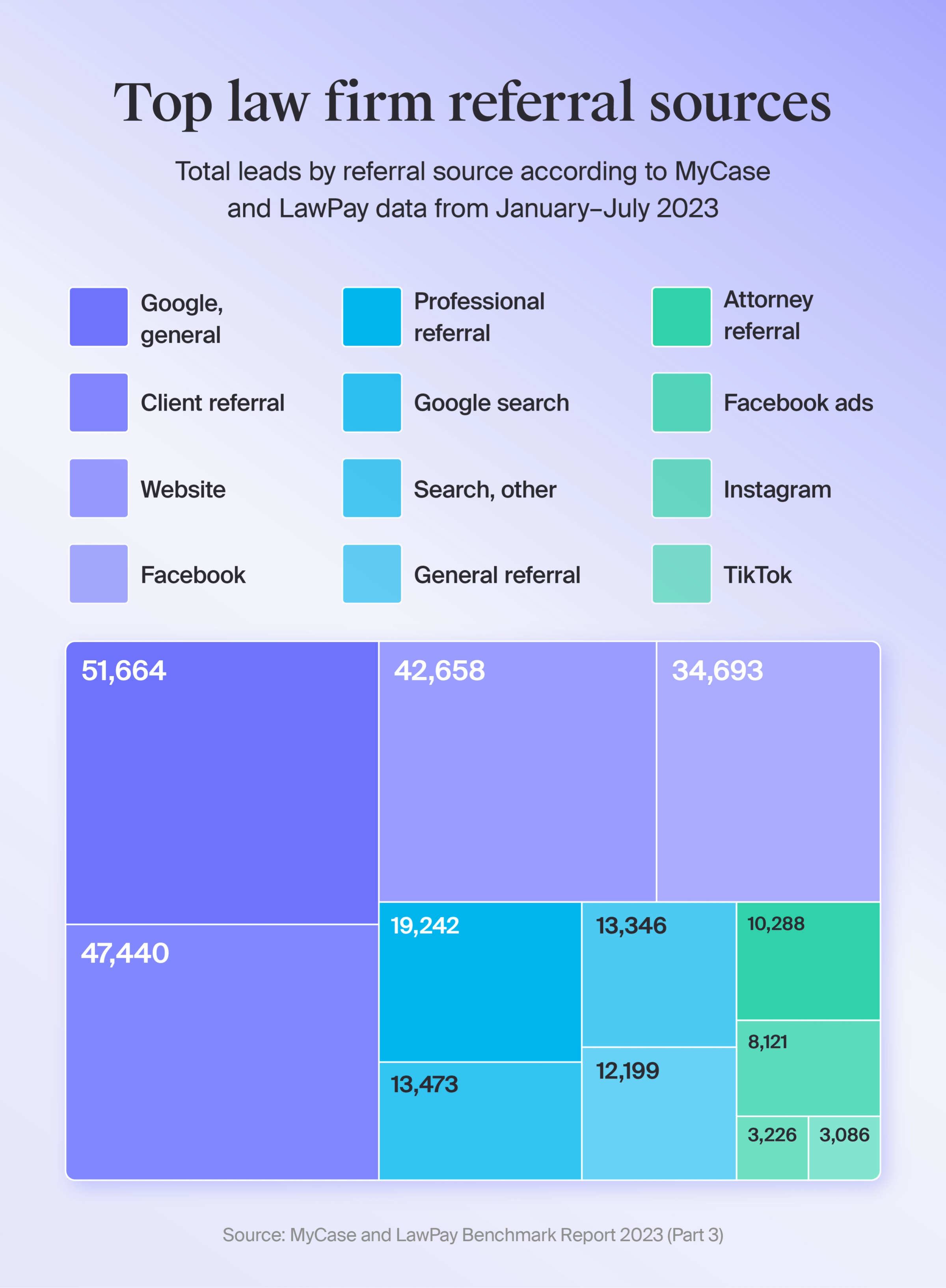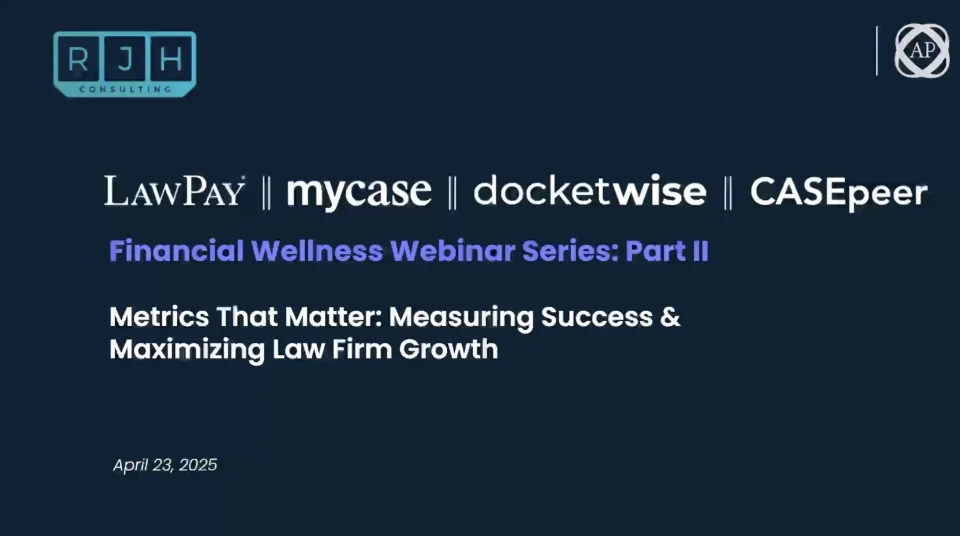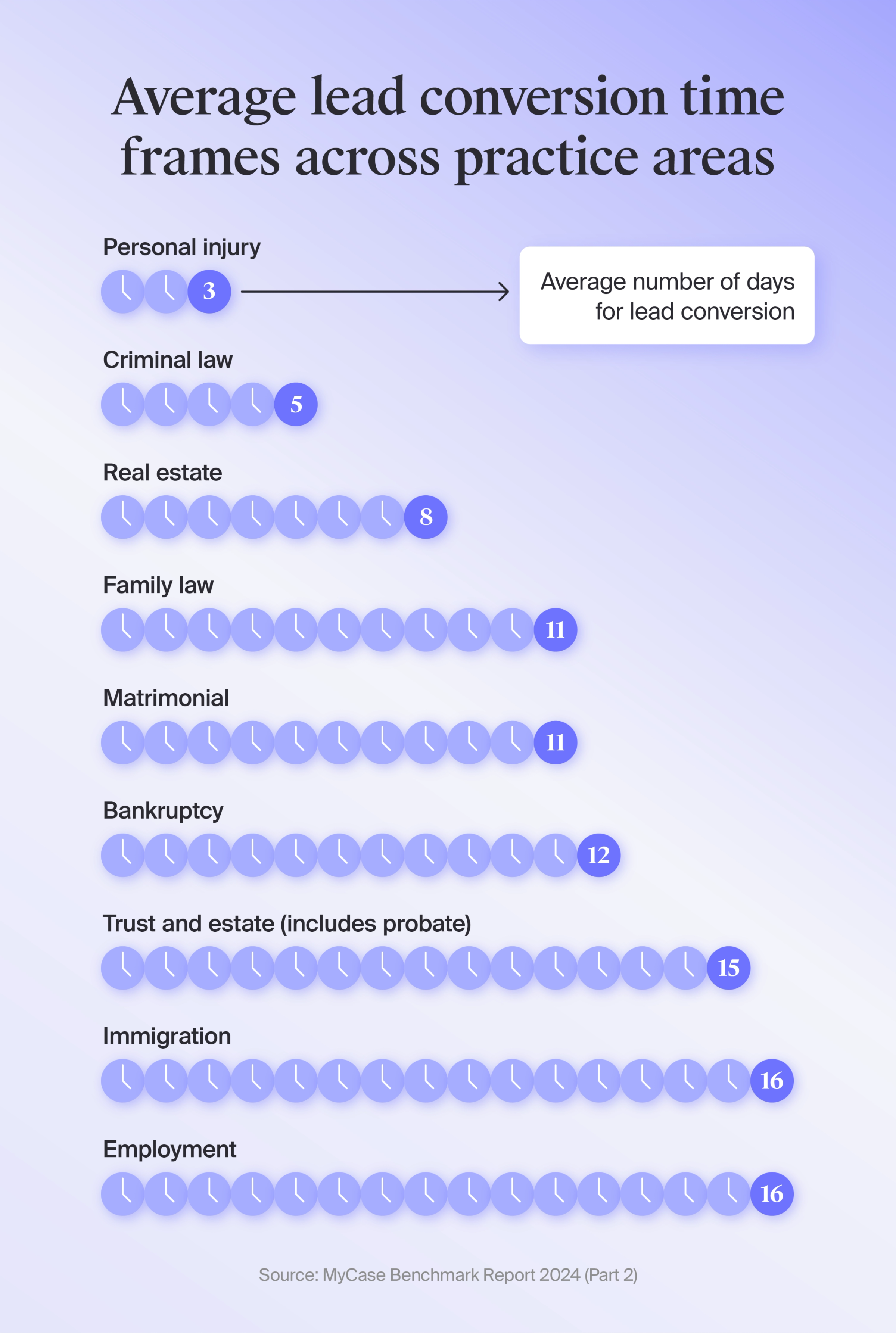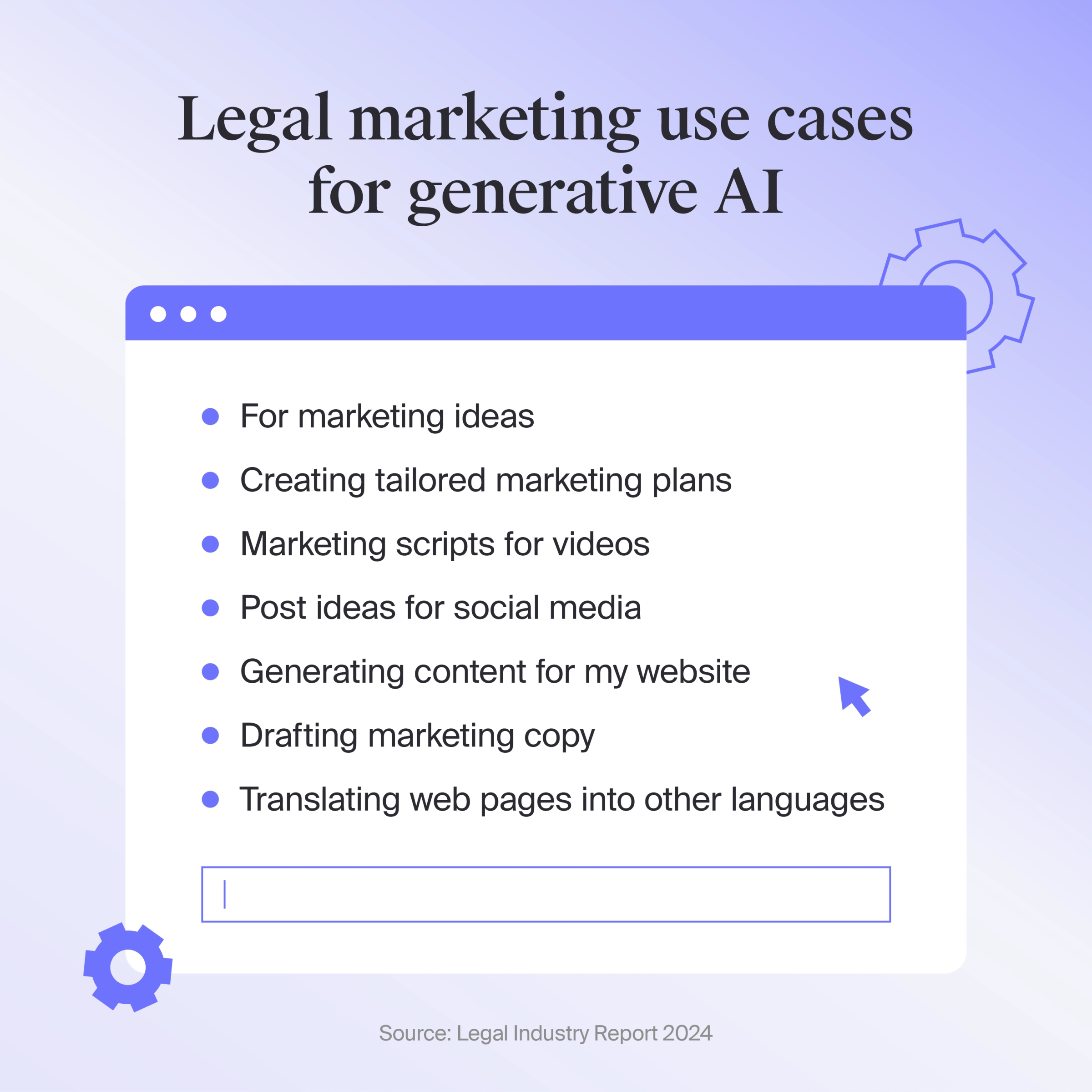Key takeaways
The most popular traditional law firm marketing channel is sponsor events (44%), followed by print media at 16%. (American Bar Association)
While 78% of law firms use paid search marketing, 82% of them find the ROI from it underwhelming. (CallRail)
Most law firms allocate 45% of their budget toward SEO, 30% toward PPC, 10% toward social media, and 15% toward traditional marketing. (FirstPageSage)
Most clients (75%) visit two to five law firm websites before contacting a firm. (FindLaw)
45% of legal professionals are using AI daily to reduce costs, including for marketing tasks like drafting social media posts. (2025 Legal Industry Trends Report)
Videos are becoming one of the most popular law firm marketing trends. (American Bar Association)
In 2024, there were 418,181 law firms in the U.S. A strong marketing presence across both traditional and digital channels can help you stand out and reach more potential clients.
At the same time, marketing is a non-billable task in most law firms, so it’s important that every effort counts toward maximizing your returns. This starts with understanding current trends in law firm marketing and expected ROI across channels.
In this guide, we will review 40+ law firm marketing statistics and connect them to the larger picture of what’s happening in legal marketing. You can use this information to refine your marketing strategy to align with industry benchmarks and emerging trends.
Traditional marketing channel performance
Many law firms have success with traditional marketing channels, with event sponsorships and print being the most common approaches. Phone calls and referrals from clients are also highly effective for bringing in new clients.
Here’s some data on the popularity and effectiveness of different traditional law firm marketing strategies:
44% of law firms sponsor or attend events, making this the most popular traditional marketing channel, followed by print marketing at 24%. (American Bar Association)
Law firms that use 8am™ MyCase gained 47,440 leads through client referrals in 2023, making it a particularly effective marketing channel. (2023 Benchmark Report: Part 3)
12% of law firms use direct mail campaigns as part of their marketing strategy. (American Bar Association)
Yellow Pages (7%) and radio (9%) are the least used traditional channels. (American Bar Association)
High-impact TV advertising is very expensive. Law firms invest $360,000+ per month in large markets like Dallas, TX, and at least $30,000+ per month in smaller ones like Utica, NY. (Rankings)
61% of inbound inquiries come from a phone call. (Ruler Analytics)
Digital marketing channel performance
Most firms use websites and social media accounts to share information, attorney profiles, and firm updates with potential and existing clients. Some firms also publish client-focused content, such as consumer guides and cases of interest.
Attorneys may use platforms like Google AdWords to run paid search campaigns, although it can be expensive to target keywords related to legal services. Local search engine optimization (SEO) is a more budget-friendly law firm marketing strategy. Even entering your business information into review sites like Yelp can help increase your firm’s visibility in local search results.
These statistics can give you an idea of the digital channels lawyers are investing in in 2025 and beyond:
In 2023, 87% of law firms had a website (down from 94% in 2021-2022). (American Bar Association)
One-third of firms maintain a blog, with adoption much higher at larger firms. (American Bar Association)
The most popular content types on law firm websites are partner profiles (96%), associate profiles (74%), and in-house legal articles (54%). (American Bar Association)
64% of law firms do not syndicate website content. Of those that do, 63% share it on social media and 42% on Law 360. (American Bar Association)
78% of law firms use paid search marketing. However, 82% don’t think the ROI is worth it. (CallRail)
Legal keywords are among the most expensive across all industries for paid search. (Fraudblocker)
The most commonly outsourced marketing activities are paid digital advertising (51%) and pay per click (PPC) campaign management (47%). (CallRail)
40% of law firms use email as part of their marketing efforts. (American Bar Association)
89% of law firms are on social networks, with LinkedIn (87%) and Facebook (62%) being the most popular social media platforms. (American Bar Association)
33% of law firms generate leads through online review sites like Yelp. (CallRail)

Lead conversion and client acquisition
Law firms generate leads from various sources, with client referrals, social media, and Google Search driving the most traffic. Also, using lead intake forms with strategic follow-up sequences can help convert leads into clients.
You can use legal CRM software to track lead sources and conversion rates. And advanced marketing automation software like HubSpot and Marketo are useful for multi-touch attribution.
Nicole Black, principal legal insight strategist at 8am™, says:
Below are some law firm marketing statistics to help you optimize lead generation:
In 2023, MyCase customers captured 58,395 leads via customized intake forms. 10,286 of these leads converted into clients—averaging a conversion rate of 17.6%. (2024 Legal Industry Trends Report)
The legal sector sees about a 2.6% conversion rate for inbound calls. (Ruler Analytics)
The average time to first payment after lead intake across all practice areas was 38 days for MyCase customers in 2024. (2024 Benchmark Report: Part 2)
The top three lead sources for law firms are Google, the firm’s website, and client referrals. (2023 Benchmark Report: Part 3)
In 2023, TikTok generated 3,086 leads, proving it can be an unexpectedly effective channel. X (formerly Twitter), on the other hand, proved quite ineffective, with most law firms seeing fewer than 5 leads from the channel. (2023 Benchmark Report: Part 3)
Among firms that use their websites to gather information about potential clients, the most common types of details collected are names (90%), phone numbers (73%), email addresses (42%), and mailing addresses (37%). (American Bar Association)
91% of law firms rely on repeat clients for business. (CallRail)


Marketing spend and ROI
Law firm marketing budgets usually depend on a firm's size and growth stage, with smaller or newer firms investing up to 10% of revenue in marketing efforts.
A large portion goes to online channels like SEO, advertising, and social media, as they tend to yield high marketing ROI for attorneys. Most law firms also allocate a significant budget to retargeting campaigns, with traditional channels receiving a much smaller share of the budget.
These ROI-focused law firm marketing statistics can help you benchmark your spending and see if your resources are going to the best-performing channels:
49% of law firms allocate an annual budget to marketing, but tracking ROI remains a challenge, with 22% reporting difficulty measuring results. (CallRail)
Online marketing receives the largest share of marketing budgets (28%), followed by print/billboard ads (19%) and TV advertising (17%). (CallRail)
On average, 46% of a firm’s marketing budget goes toward remarketing efforts, yet only 18% of firms use multi-touch attribution to fully understand campaign performance. (CallRail)
Firms are actively increasing marketing investment in high-impact channels: 66% plan to increase website budgets, 60% social media, and 48% paid advertising. (CallRail)
28% of firms say they feel pressured to compete with larger firms’ SEO budgets. (CallRail)
Overall budget allocation trends show 45% toward SEO, 30% PPC, 10% social media, and 15% traditional marketing. (FirstPageSage)
In 2025, 69% of smaller firms (less than 25 employees) and 79% of larger firms say they plan to increase their marketing budget in the next 12 months. (Rankings)
Client behavior and expectations
Most clients consult professional directories and visit several law firm websites before reaching out via a phone call. This means it’s important for law firms to both maintain a strong brand presence online and optimize websites for usability—especially on mobile browsers.
Also, while clients are usually okay with a few hours’ wait for a response, faster replies do improve conversion rates. Here are some stats to help you understand what clients expect during their research and outreach process:
46% of clients first contact law firms by phone, while 27% reach out by email. (CallRail)
41% of law firms receive traffic from clients using digital legal professional directories. (CallRail)
76% of people would leave a law firm website if it didn’t provide enough information about the firm. (iLawyerMarketing)
69% of visitors abandon a law firm’s website if it loads slowly, with mobile performance being the main issue. (iLawyerMarketing)
Over 75% of clients visit two to five websites before contacting an attorney. (FindLaw)
More than 70% of clients initially contact attorneys by phone, and 50% expect a same-day response. (FindLaw)
A five-hour delay in responding to client inquiries can result in 46 lost clients per year—potentially up to $200,000 in revenue. (CallRail)
Emerging trends and technology in law firm marketing
Like the rest of the marketing world, law firms are experimenting with AI for marketing and visual media, such as videos, to promote their practices. However, adoption is moving slowly, often due to the time required to research new tools and limited reliable information.
Here are some law firm marketing trends to be aware of:
45% of legal professionals are using AI daily. This includes creating business plans and drafting marketing content like social media posts and blogs. (2025 Legal Industry Trends Report)
30% of firms create videos to help market their practice. (American Bar Association)
12% of law firms have integrated live chat into their website to engage clients in real time. (American Bar Association)
98% of law firms say client intake software helps them make data-backed marketing decisions. (CallRail)
The top reasons law professionals did not research any new software were: research is too time-consuming (44%) and not enough unbiased information is available (28%). (2024 Legal Industry Trends Report)

Simplify lead management with MyCase
The statistics in this article show a clear pattern: Digital channels drive most leads; clients often research several firms before reaching out; and how quickly you respond can make or break a conversion.
Capturing detailed information about your leads is also essential. The better your data, the easier it is to follow up, convert leads, and identify which marketing channels work best for each practice area in your firm.
Client intake and lead management tools built into MyCase make this easy. They centralize lead tracking, automate follow-ups, and keep client details organized. Dynamic client intake forms that adjust automatically as they are filled out, and tools that track leads by practice area and marketing channel can help optimize future marketing budgets.
Schedule a demo and see how MyCase can help you simplify client intake and make data-driven marketing decisions.
Frequently asked questions
About the author

Justin FisherContent Writer
Justin Fisher is a content writer and SEO strategist for leading legal software companies, including MyCase, Docketwise, and CASEpeer, as well as LawPay, the #1 legal payment processor. He specializes in writing about emerging legal technology, financial wellness for law firms, and more.
